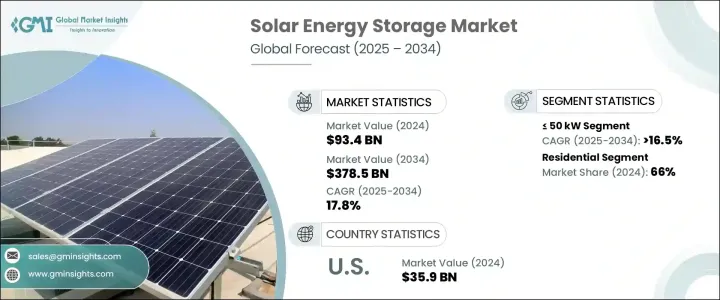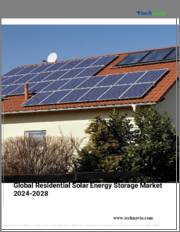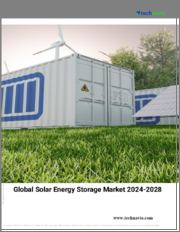
|
시장보고서
상품코드
1716507
태양에너지 저장 시장 기회, 성장 촉진 요인, 산업 동향 분석, 예측(2025-2034년)Solar Energy Storage Market Opportunity, Growth Drivers, Industry Trend Analysis, and Forecast 2025 - 2034 |
||||||
세계 태양에너지 저장 시장은 2024년에 934억 달러로 평가되었으며, 2025년부터 2034년까지의 CAGR은 17.8%를 나타낼 전망입니다.
이 두드러진 성장 궤도는 환경 문제에 대한 관심 증가, 유리한 정부 인센티브, 에너지 저장 기술의 발전의 조합에 의해 초래됩니다. 세계 각국이 이산화탄소 배출량의 삭감과 재생 가능 에너지의 추진에 힘을 쏟고 있는 가운데 태양광 및 저장 솔루션이 에너지 전환에 필수적인 요소가 되고 있습니다. 다양한 지역 정부가 세금 공제 및 보조금과 같은 유리한 인센티브를 도입하여 태양광 에너지 저장 시스템의 도입을 촉진하고 있습니다. 또한, 넷미터링 정책은 자가발전과 축전을 하는 유저에게 금전적인 장점을 제공하고, 태양광 에너지 저장 시스템은 주택 소유자와 기업에 보다 매력적이 되고 있습니다.

혁신은 또한 시장의 궤도를 형성하는 중요한 요소입니다. 배터리 기술, 특히 리튬 이온 배터리의 지속적인 발전은 비용 효율성을 높이고 태양에너지 저장 솔루션의 전반적인 성능을 향상시킵니다. 이러한 기술 혁신으로 에너지 저장 시스템은 보다 폭넓은 용도로 이용하기 쉬워지고 신뢰성도 높아지고 있습니다. 또한 AI를 활용한 에너지 관리 시스템의 통합으로 배터리 효율이 향상되고 에너지의 최적 이용이 보장되고 낭비가 최소화됩니다. 이러한 기술이 주류가 됨에 따라 채택이 급증하고 시장 확대를 더욱 촉진할 것으로 예측됩니다.
| 시장 범위 | |
|---|---|
| 시작 연도 | 2024년 |
| 예측 연도 | 2025-2034년 |
| 시작 금액 | 934억 달러 |
| 예측 금액 | 3,785억 달러 |
| CAGR | 17.8% |
51-250kW의 태양에너지 저장 분야는 상업 빌딩, 중소기업, 커뮤니티 기반 태양광 발전 프로젝트 수요 증가가 주요 요인이 되어 2034년까지 350억 달러에 달할 것으로 예측되고 있습니다. 상업시설은 태양광 및 저장 시스템의 비용 절감 가능성을 인식하고 있으며 장기 운영 비용을 줄이기위한 매력적인 투자가되었습니다. 또한 AI 기반 에너지 관리 플랫폼이 배터리 성능을 최적화하고 실시간 통찰력을 제공함으로써 이러한 저장 솔루션의 채택이 가속화되고 있습니다.
시장은 주택용, 상업 및 산업용, 유틸리티 스케일의 용도로 구분됩니다. 전기 요금의 상승과 송전망의 신뢰성에 대한 우려가 주택 소유자에게 태양에너지 저장 솔루션에 대한 투자를 촉구하고 있습니다.
미국의 태양에너지 저장 시장은 환경 의식의 고조와 에너지 비용의 상승을 배경으로 2024년에 359억 달러를 창출했습니다. 주택, 상업 및 산업 분야에서 태양에너지 저장 시스템의 채택이 확산되고 있습니다.
목차
제1장 조사 방법과 조사 범위
제2장 주요 요약
제3장 업계 인사이트
- 생태계 분석
- 규제 상황
- 업계에 미치는 영향요인
- 성장 촉진요인
- 업계의 잠재적 위험 및 과제
- 성장 가능성 분석
- Porter's Five Forces 분석
- PESTEL 분석
제4장 경쟁 구도
- 소개
- 전략적 전망
- 혁신과 지속가능성의 전망
제5장 시장 규모와 예측 : 조성별, 2021년-2034년
- 주요 동향
- 납산
- 리튬 이온
제6장 시장 규모와 예측 : 용량별, 2021년-2034년
- 주요 동향
- 50 kW 이하
- 51-250 kW
- 251-500 kW
- 501-1,000 kW
- 1,001-2,500 kW
- 2,501-5,000 kW
- 5,001-10,000 kW
- 10,000 kW 초과
제7장 시장 규모와 예측 : 설치별, 2021년-2034년
- 주요 동향
- 온그리드
- 오프 그리드
제8장 시장 규모와 예측 : 용도별, 2021년-2034년
- 주요 동향
- 주택
- 상업 및 산업
- 유틸리티
제9장 시장 규모와 예측 : 지역별, 2021년-2034년
- 주요 동향
- 북미
- 미국
- 캐나다
- 유럽
- 독일
- 프랑스
- 이탈리아
- 스페인
- 영국
- 스위스
- 오스트리아
- 아시아태평양
- 중국
- 일본
- 인도
- 호주
- 한국
- 중동 및 아프리카
- 사우디아라비아
- 아랍에미리트(UAE)
- 남아프리카
- 라틴아메리카
- 브라질
- 아르헨티나
제10장 기업 프로파일
- ABB
- BAE Batteries
- BYD Company
- Eaton
- ENERSYS
- Honeywell International
- Huawei
- Innova Renewables
- Leclanche SA
- LG Electronics
- Maxwell Technologies
- NextEra Energy
- Primus Power
- Saft
- SAMSUNG
- Schneider Electric
- Siemens Energy
- Sol Systems
- Tesla
- Toshiba Corporation
The Global Solar Energy Storage Market, valued at USD 93.4 billion in 2024, is poised for significant growth, with a CAGR of 17.8% projected during 2025-2034. This remarkable growth trajectory is driven by a combination of rising environmental concerns, favorable government incentives, and advancements in energy storage technology. As nations worldwide intensify their focus on reducing carbon emissions and promoting renewable energy, solar-plus-storage solutions are becoming an essential part of the energy transition. Governments across multiple regions are introducing lucrative incentives, such as tax credits and subsidies, to encourage the adoption of solar energy storage systems. Additionally, net metering policies are providing financial benefits to users who generate and store their own energy, making solar energy storage systems more appealing to homeowners and businesses alike.

Technological innovation is another key factor shaping the market's trajectory. Continuous advancements in battery technology, especially lithium-ion batteries, are driving cost efficiencies and improving the overall performance of solar energy storage solutions. These innovations are making energy storage systems more accessible and reliable for a broader range of applications. Furthermore, the integration of AI-powered energy management systems is enhancing battery efficiency, ensuring optimal energy usage, and minimizing wastage. As these technologies become more mainstream, their adoption is expected to surge, further driving market expansion.
| Market Scope | |
|---|---|
| Start Year | 2024 |
| Forecast Year | 2025-2034 |
| Start Value | $93.4 Billion |
| Forecast Value | $378.5 Billion |
| CAGR | 17.8% |
The 51 to 250 kW solar energy storage segment is projected to reach USD 35 billion by 2034, largely driven by increasing demand from commercial buildings, small businesses, and community-based solar projects. Commercial facilities are recognizing the cost-saving potential of solar-plus-storage systems, making them an attractive investment for reducing long-term operational costs. Moreover, AI-based energy management platforms are optimizing battery performance and providing real-time insights, which is accelerating the adoption of these storage solutions.
The market is segmented into residential, commercial & industrial, and utility-scale applications. In 2024, the residential solar energy storage segment held a commanding 66% market share, reflecting a growing trend toward energy independence among homeowners. Rising electricity costs and concerns over grid reliability are pushing homeowners to invest in solar energy storage solutions. Moreover, solar-plus-storage systems are enhancing property values, making them an attractive investment for long-term financial returns.
The U.S. Solar Energy Storage Market generated USD 35.9 billion in 2024, driven by growing environmental consciousness and rising energy costs. With a strong emphasis on adopting energy-efficient technologies and reducing dependence on fossil fuels, the United States is witnessing widespread adoption of solar energy storage systems across residential, commercial, and industrial sectors. As more individuals and businesses prioritize sustainability, the demand for solar energy storage solutions is expected to maintain strong momentum in the coming years.
Table of Contents
Chapter 1 Methodology & Scope
- 1.1 Market scope & definitions
- 1.2 Market estimates & forecast parameters
- 1.3 Forecast calculation
- 1.4 Data sources
- 1.4.1 Primary
- 1.4.2 Secondary
- 1.4.2.1 Paid
- 1.4.2.2 Public
Chapter 2 Executive Summary
- 2.1 Industry synopsis, 2021 - 2034
Chapter 3 Industry Insights
- 3.1 Industry ecosystem analysis
- 3.2 Regulatory landscape
- 3.3 Industry impact forces
- 3.3.1 Growth drivers
- 3.3.2 Industry pitfalls & challenges
- 3.4 Growth potential analysis
- 3.5 Porter's analysis
- 3.5.1 Bargaining power of suppliers
- 3.5.2 Bargaining power of buyers
- 3.5.3 Threat of new entrants
- 3.5.4 Threat of substitutes
- 3.6 PESTEL analysis
Chapter 4 Competitive Landscape, 2024
- 4.1 Introduction
- 4.2 Strategic outlook
- 4.3 Innovation & sustainability landscape
Chapter 5 Market Size and Forecast, By Composition, 2021 – 2034 (MW & USD Million)
- 5.1 Key trends
- 5.2 Lead acid
- 5.3 Lithium ion
Chapter 6 Market Size and Forecast, By Capacity, 2021 – 2034 (MW & USD Million)
- 6.1 Key trends
- 6.2 ≤ 50 kW
- 6.3 51 to 250 kW
- 6.4 251 to 500 kW
- 6.5 501 to 1,000 kW
- 6.6 1,001 to 2,500 kW
- 6.7 2,501 to 5,000 kW
- 6.8 5,001 to 10,000 kW
- 6.9 > 10,000 kW
Chapter 7 Market Size and Forecast, By Installation, 2021 – 2034 (MW & USD Million)
- 7.1 Key trends
- 7.2 On-grid
- 7.3 Off-grid
Chapter 8 Market Size and Forecast, By Application, 2021 – 2034 (MW & USD Million)
- 8.1 Key trends
- 8.2 Residential
- 8.3 Commercial & industrial
- 8.4 Utility
Chapter 9 Market Size and Forecast, By Region, 2021 – 2034 (MW & USD Million)
- 9.1 Key trends
- 9.2 North America
- 9.2.1 U.S.
- 9.2.2 Canada
- 9.3 Europe
- 9.3.1 Germany
- 9.3.2 France
- 9.3.3 Italy
- 9.3.4 Spain
- 9.3.5 UK
- 9.3.6 Switzerland
- 9.3.7 Austria
- 9.4 Asia Pacific
- 9.4.1 China
- 9.4.2 Japan
- 9.4.3 India
- 9.4.4 Australia
- 9.4.5 South Korea
- 9.5 Middle East & Africa
- 9.5.1 Saudi Arabia
- 9.5.2 UAE
- 9.5.3 South Africa
- 9.6 Latin America
- 9.6.1 Brazil
- 9.6.2 Argentina
Chapter 10 Company Profiles
- 10.1 ABB
- 10.2 BAE Batteries
- 10.3 BYD Company
- 10.4 Eaton
- 10.5 ENERSYS
- 10.6 Honeywell International
- 10.7 Huawei
- 10.8 Innova Renewables
- 10.9 Leclanche SA
- 10.10 LG Electronics
- 10.11 Maxwell Technologies
- 10.12 NextEra Energy
- 10.13 Primus Power
- 10.14 Saft
- 10.15 SAMSUNG
- 10.16 Schneider Electric
- 10.17 Siemens Energy
- 10.18 Sol Systems
- 10.19 Tesla
- 10.20 Toshiba Corporation



















